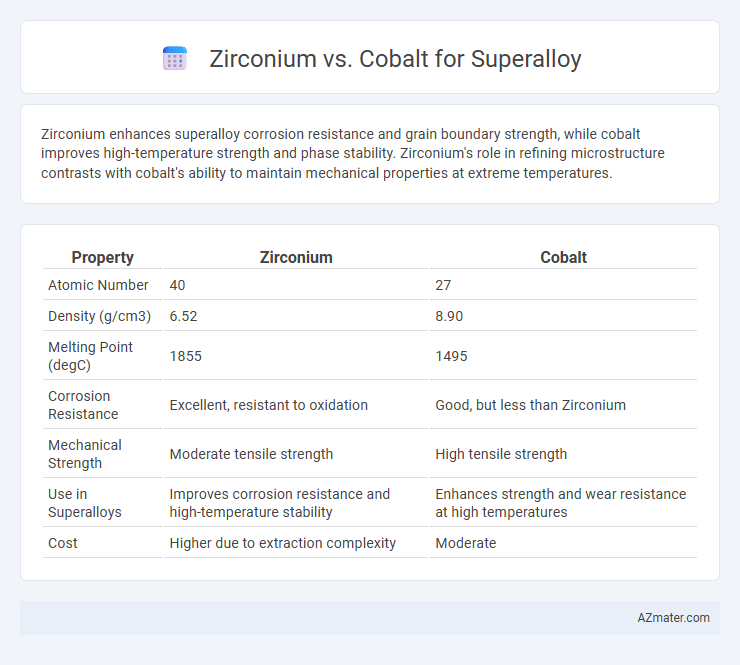Zirconium enhances superalloy corrosion resistance and grain boundary strength, while cobalt improves high-temperature strength and phase stability. Zirconium's role in refining microstructure contrasts with cobalt's ability to maintain mechanical properties at extreme temperatures.
Table of Comparison
| Property | Zirconium | Cobalt |
|---|---|---|
| Atomic Number | 40 | 27 |
| Density (g/cm3) | 6.52 | 8.90 |
| Melting Point (degC) | 1855 | 1495 |
| Corrosion Resistance | Excellent, resistant to oxidation | Good, but less than Zirconium |
| Mechanical Strength | Moderate tensile strength | High tensile strength |
| Use in Superalloys | Improves corrosion resistance and high-temperature stability | Enhances strength and wear resistance at high temperatures |
| Cost | Higher due to extraction complexity | Moderate |
Introduction to Superalloys: The Role of Alloying Elements
Superalloys are high-performance materials designed for extreme environments, relying heavily on specific alloying elements to enhance properties such as strength, oxidation resistance, and thermal stability. Zirconium improves superalloy performance by refining grain boundaries and increasing corrosion resistance, while cobalt primarily boosts high-temperature strength and phase stability. The choice between zirconium and cobalt depends on the target application requirements, balancing factors like creep resistance and environmental durability.
Zirconium vs Cobalt: Chemical and Physical Properties
Zirconium exhibits a high melting point of 1855degC, excellent corrosion resistance, and low neutron absorption, making it ideal for nuclear and aerospace superalloys. Cobalt, with a melting point of 1495degC, offers superior strength and wear resistance but is denser and less corrosion-resistant than zirconium. The chemical inertness and low density of zirconium contrast with cobalt's magnetic properties and higher tensile strength, influencing their specialized applications in superalloys.
Mechanical Strength Comparison: Zirconium vs Cobalt Superalloys
Zirconium superalloys typically exhibit superior mechanical strength at elevated temperatures due to enhanced grain boundary cohesion and oxidation resistance compared to cobalt superalloys. Cobalt-based superalloys provide excellent wear resistance and toughness but generally have lower creep resistance under high-stress conditions than zirconium alloys. When considering structural applications requiring sustained mechanical integrity at extreme temperatures, zirconium superalloys often outperform cobalt variants in terms of tensile strength and fatigue life.
Corrosion and Oxidation Resistance in High-Temperature Environments
Zirconium-containing superalloys exhibit enhanced corrosion and oxidation resistance at high temperatures due to the formation of stable zirconium oxide scales that protect the alloy surface. Cobalt-based superalloys offer superior oxidation resistance, particularly in hydrogen-rich and sulfur-containing environments, by forming adherent and dense oxide layers. Zirconium improves overall thermal stability and corrosion resistance in harsh oxidative conditions, while cobalt contributes to mechanical strength and oxidation resistance in aggressive high-temperature atmospheres.
Heat Resistance and Thermal Stability: Key Differences
Zirconium offers superior heat resistance and thermal stability in superalloys due to its high melting point (about 1855degC) and ability to form stable oxide layers that protect against oxidation at elevated temperatures. Cobalt-based superalloys exhibit excellent thermal stability and maintain strength at high temperatures, often above 1000degC, but Zirconium's oxide scale provides enhanced protection for prolonged exposure to extreme heat. This makes Zirconium particularly valuable in applications where prolonged thermal endurance and oxidation resistance are critical, outperforming Cobalt in long-term high-temperature environments.
Applications in Aerospace and Industrial Sectors
Zirconium in superalloys enhances corrosion resistance and high-temperature stability, making it ideal for aerospace turbine components and jet engines where material longevity is critical. Cobalt-based superalloys excel in thermal fatigue resistance and strength retention at extreme temperatures, widely used in gas turbine blades and industrial gas turbines. Both elements contribute to advanced superalloys, with zirconium favored for oxidation resistance and cobalt for mechanical strength under high stress in aerospace and industrial applications.
Cost and Availability of Zirconium and Cobalt for Superalloys
Zirconium is generally more abundant and cost-effective than cobalt, making it a preferred choice for superalloys requiring high corrosion resistance and low neutron absorption. Cobalt, while offering superior strength and thermal stability at elevated temperatures, is significantly more expensive and faces supply chain volatility due to geopolitical factors. The cost and availability disparities influence material selection in superalloy manufacturing, with zirconium providing a more stable and affordable option compared to the critical and costly cobalt.
Environmental and Safety Considerations
Zirconium-based superalloys offer superior corrosion resistance and lower toxicity compared to cobalt, reducing environmental hazards during manufacturing and disposal processes. Cobalt poses significant health risks due to its potential for causing respiratory issues and environmental contamination from mining and refining. Selecting zirconium alloys enhances workplace safety and aligns with stricter environmental regulations targeting heavy metal emissions.
Future Trends in Superalloy Development: Zirconium or Cobalt?
Future trends in superalloy development highlight zirconium's increasing role in enhancing creep resistance and oxidation stability at high temperatures, outperforming traditional cobalt-based alloys. Zirconium's ability to refine grain structures and improve alloy phase stability positions it as a critical element for next-generation turbine engines and aerospace applications. While cobalt remains valuable for its thermal and mechanical properties, zirconium's integration promises significant advancements in durability and performance under extreme operating conditions.
Conclusion: Choosing the Right Element for Superalloy Performance
Cobalt enhances superalloy performance with excellent high-temperature strength and corrosion resistance, making it ideal for gas turbine engines. Zirconium improves grain boundary cohesion and oxidation resistance, contributing to alloy durability under extreme conditions. Selecting the right element depends on specific application demands, balancing temperature tolerance, mechanical properties, and environmental stability for optimal superalloy performance.

Infographic: Zirconium vs Cobalt for Superalloy
 azmater.com
azmater.com